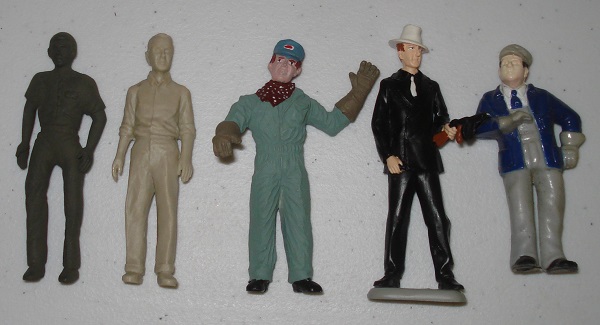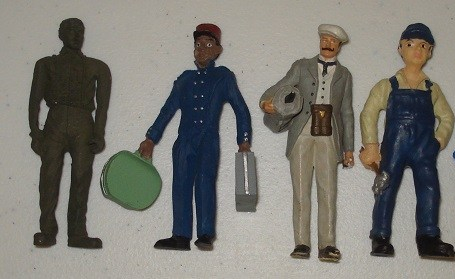Like most modelers I used a ruler to measure scale. When Scale Card came out with their product I thought it was the greatest thing since sliced bread and carried it for years. After a while its limitations became evident. It is two dimensional and does not reflect an average human in either height or weight. Since model sculptors do not strive to make their figures to specific standards I realized I needed an example of the average male physique around the age of 25. Basically a young man in good shape. Also for it to be truly useful it needed to be 3 dimensional.
A quick search on the internet provided a baseline. According to the LiveStrong Foundation the average North American Male in good condition should be 5′ 10″ at 180 lbs (note that the average median is 195 lbs). Some quick calculations for height and a few photos of examples for weight and I created a plain standing figure representative of those measurements. I ended up making three examples; one in each scale of 1/20.3 (Accucraft), 1/22.5 (LGB) and 1/24th (HLW).
From left to right below: a 1/18th figure for reference, 1/20.3 casting figure, 1/22.5 one off figure and a 1/24th one off figure. The casting figure is the final version I made copies of and handed out to my Figures Clinic attendees at the 2017 National Garden Railroad Convention in Tulsa.

I call this item “Green Man” after the sculpting figures used in miniature war-game manufacturing. In the late seventies figures for Roleplay (Dungeons & Dragons etc) were made one at a time with only loose standards applied to scale. Due to this size variation a group of adventure figures often looked like a collection of kids toys rather than a diorama model. When mass combat games came along the need for identical figures with different weapons and armor quickly became evident. Sculptors created a basic shape similar to an artists mannequin. These were reproduced and then used as the basic form to which individual variations could be made. The end result was all of the figures in a single range were very close in size yielding a professional and serious group of models. The term, green man, came from the two part sculpting epoxy that was used. Once the blue and yellow components were mixed they turned green remaining pliable for several hours allowing the sculptor to fashion whatever details were needed. The figures in their raw form were a dull camo-green. The name stuck and then spread to include any unpainted figure sculpt. The figures below are 25mm. As you can see sculptors in that hobby are ridiculously talented.
To use Green Man simply compare it to the figure in question. Height is usually the first thing we look at but the other two most important measurements are the width of the shoulders and the circumference of the head. In an average person these two measurements have much less variation than height. Of secondary interest is the length of the arms and the girth of the waist. I usually allow for 3 scale inches in height up or down and then eyeball the head and chest size to see if they look right.
Here is 1/24th Green Man compared to figures from: Model Citizens (1/24th line), Woodland Scenic, Motorheads (1/24th line) and Lionel (large scale line). All of the manufacturers claim to be 1/24th scale except Woodland Scenics who publish no scale and in fact their “G” scale figures span the range from 1/24th to 1/20.3.

1/22.5 Green Man with figures from: Woodland Scenics, Prieser and Just Plain Folks.

Finally 1/20.3 Green Man compared to figures from: Fine Folks, Model Citizens (1/20.3 line), Cheaple (my limited figure line), Fun and Games and Schleich ( no advertised scale).

That is the story of Green Man. I think if you make one for your scale you will discover it is time well spent.



You must be logged in to post a comment.